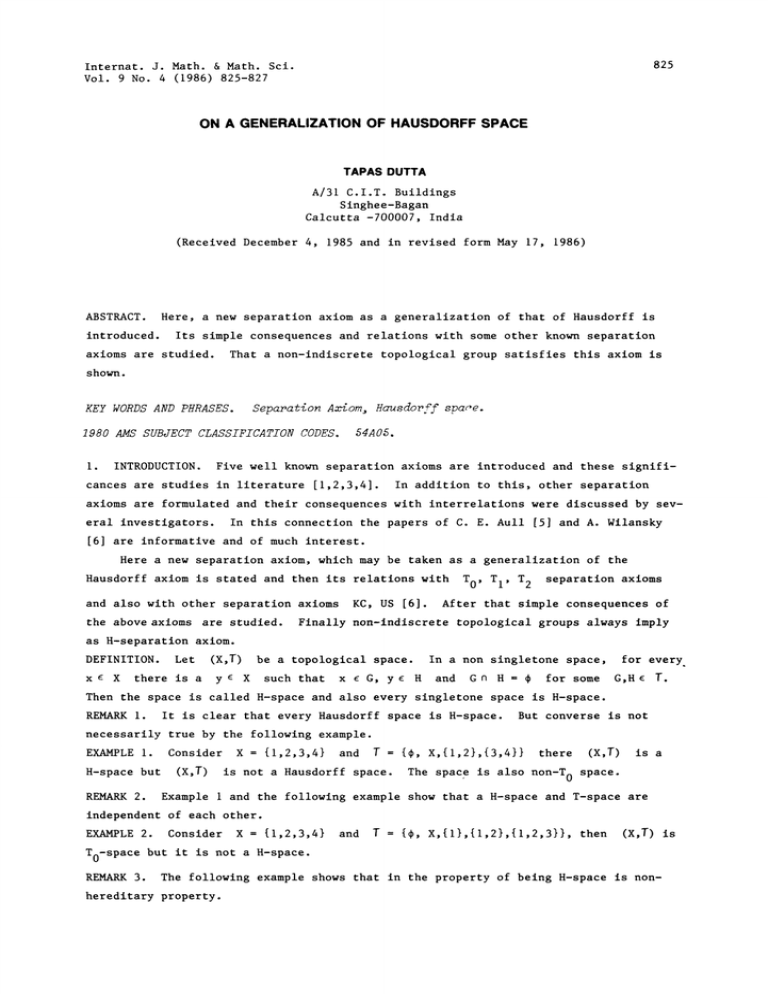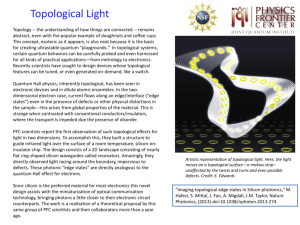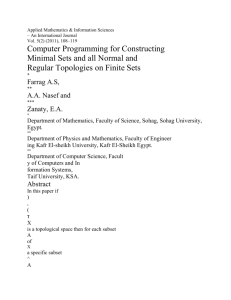HAUSDORFF SPACE ON A GENERALIZATION OF
advertisement

825
Internat. J. Math. & Math. Sci.
Vol. 9 No. 4 (1986) 825-827
ON A GENERALIZATION OF HAUSDORFF SPACE
TAPAS DUTTA
A/31 C.I.T. Buildings
Singhee-Bagan
Calcutta -700007, India
(Received December 4, 1985 and in revised form May 17, 1986)
ABSTRACT.
Here, a new separation axiom as a generalization of that of Hausdorff is
introduced.
Its simple consequences and relations with some other known separation
axioms are studied.
That a non-indiscrete topological group satisfies this axiom is
shown.
1980 AMS SUBJECT CLASSIFICATION CODES.
I.
INTRODUCTION.
Hausdoff
Separation Axiom,
KEY WORDS AND PHRASES.
spac, e.
54A05.
Five well known separation axioms are introduced and these signifi-
cances are studies in literature [1,2,3,4].
In addition to this, other separation
axioms are formulated and their consequences with interrelations were discussed by sev-
In this connection the papers of C. E. Aull [5] and A. Wilansky
eral investigators.
[6] are informative and of much interest.
Here a new separation axiom, which may be taken as a generalization of the
Hausdorff axiom is stated and then its relations with
KC, US [6].
and also with other separation axioms
the above axioms are studied.
T
O
T I, T
2
separation axioms
After that simple consequences of
Finally non-indiscrete topological groups always imply
as H-separatlon axiom.
DEFINITION.
x
X
Let
there is a
(X,T)
be a topological space.
X
y
such that
x
G, y
In a non singletone space, for
H and G n H
for some G,H
every.
Then the space is called H-space and also every singletone space is H-space.
REMARK I.
It is clear that every Hausdorff space is H-space.
But converse is not
necessarily true by the following example.
EXAMPLE i.
H-space but
REMARK 2.
Consider
(X,I)
Example
X
{1,2,3,4}
and
T
is not a Hausdorff space.
{, X,{1,2},{3,4}}
there
(X,)
is a
The spac9 is also non-T space.
O
and the following example show that a H-space and T-space are
independent of each other.
EXAMPLE 2.
T0-space
REMARK 3.
Consider
X
{1,2,3,4}
and
{, X,{I},{1,2},{1,2,3}}, then
(X,)
but it is not a H-space.
The following example shows that in the property of being H-space is non-
hereditary property.
is
T. DUTTA
826
EXAMPLE 3.
{1,2,3,4,5}
X
Consider
T
and
Now consider the sub-space {1,2,3}
H-space.
A
REMARK 4.
T0-space
{, X,{1,2,3},{4,5}}
(X,I)
then
is
which is not a H-space.
which is also H-space is not necessarily a
(by the
T1-space
following example).
EXAMPLE 4.
{1,2,3}
{1,2,3,4}
X
Consider
Now it is clearly a
{, X,{I},{1,2},{3},{3,4},{1,3},{1,3,4},
also a H-space. But (X,I) is not a
and
T0-space
and
Tl-space.
REMARK 5.
and the following example shows that a H-space and a
Example
T1-space
are
independent of each other.
EXAMPLE 5.
R
Consider
REMARK 6.
A
but it is not H-space.
which is also H-space is not necessarily a
Tl-space
It is
is the set of all real numbers with cofinite topology.
T
clear that the space is
T2-space
(by the fol-
lowing example).
EXAMPLE 6.
X*
{0,1,2,3
(X*,T*)
Then clearly
DEFINITION [6].
and the topology
T*
and
{G, G u {}
is cofintite topo-
T}.
G
is a topological space and it is clear that the space is
as well as H-space.
T1-space
{1,2,3,4
X
Let us consider
Now let
logy.
But the space is not a
T2-space.
A topological space is called KC-space if every compact set is
closed.
REMARK 7.
and the following example shows that a H-space and a KC-space
Example
are independent of each other.
EXAMPLE 7.
Let us consider
be the set of all positive real numbers with co-
It is clear that the space is KC-space.
countable topology.
REMARK 8.
R+
But it is not a H-space.
A KC-space which is also H-space is not necessarily a
T2-space
(by the fol-
lowing example).
EXAMPLE 8.
R+
Consider
topology I.
Now let
G u {0}:
}.
G e
be the set of all positive real numbers with co-countable
be the set of all non-negative real numbers and
Then clearly
(R,)
DEFINITION [6].
{G,
is a topological space and it is clear that
But the space is not a
KC-space as well as H-space.
the space is
T
T2-space.
A topological space is called a US-space if every convergent sequence
has exactly one limit to which it converges.
REMARK 9.
(a)
Remark 5 and Remark 7 shows that US-space and H-space are independent
of each other.
(b)
RESULT i.
X
X
Y
-i
(V)
U,V
and
(Y,T2)
Y
(forom [6]).
T2
be two topological spaces.
Y
is
T2-space.
Then
If a non-constant
X
is a non-constant function, so for every
f(x) # f(y).
such that
f
US => T
is continuous and
X
f:
Since
there are
and
=> KC =>
T2-space.
(X,TI)
Let
f:
function
ye
2
From the above example 8 it is clear that a US-space which is also H-space
is not necessarily a
PROOF.
T
Since
such that
Since
f(x)
f(x), f(y)
U,
f(y)
Y
V
are mutually disjoint non-empty open in
and
and
Y
is
U OV
X [since
f
is a
.
H-space.
x e X
there is a
T2-space
Then
Hence
f-l(u)
is continuous].
GENERALIZATION OF HAUSDORFF SPACE
f-l(u)
x e
H-space.
Let
X
V
T 2,
V
RESULT 3.
PROOF.
Let
and
Hence
x e X
A
x
B
By
yb
-Iv.
V
A
and
U.
B
b e B.
A, then
So
V, y e U
so
V’
and
UI,V
c
such that
If
is closed in
xV
X.
x
T
x
-I e
By-1
V
2
such that
o
b
such that
U
B
-I.
x e
y
But
-I
x-lvy-1
b
V n V
-i
.
B-
e
V’
x e
y e
B.
So
U
is a open
x c yB
so
-I
B-ly-I
x
-1.
A
A
B
Then
X, there is
Let
Let
such that
Then
e e Vy
Then
V I, V’
U
So
V
y
y e X
a
such that
be the complement of V,
.
VI,U
V o U
and
T.
Since
So there are
Hence
VI,V 2
xe V 2, y V
V
and
and
is H-space.
ye
V’.
such that
V
V
x
X
is open in
ye V, so
e
Then
(X,)
Hence
is non-empty so there is a
2
yB.
H-space.
is
Case I:
Let
U.
x
x
eT.
V,U
x V’ (complement of V).
V
X.
y e X
U
Let
(X,I)
Since every topological group is regular, so
for some
then
Since
And if
(since
Then
e(identity).
For suppose
-i -i
Ay
xe V’, y e V’.
V
T I.
2
(VU)
X, so there is a
B
for some
topological group is regular space.
V
(VIU)
and
Hence we get, for every
U, y
x
-i
Then
U.
x
is closed and
there are
V I, V
for some
2
is a open neighborhood of
e
y.
is a
is a H-space, then there is a
be a non-empty proper open set in
x
x
V’
n V
(X,T I)
If
H-space.
We claim that
contradiction.
Case II:
is a
is a open neighborhood of
Now
y e U
V
H-space.
is
spaces.
be a non-indiscrete topological group.
and
Then
for some
1.
2
be a non-empty proper open set in
neighborhood of
x
XY
(X,T)
Let
V
X
Since
VIU. (xl,Y) V2U
(x,y) c
then
Let
V
Then
x e V I, x
X
Hence
H-space.
is also a
XY.
=).
2
since
y
(x,y) be any point in
such that
U
y
.
and
and
Then the product space
PROOF.
x
(X,T I)
Let
f-l(u) n f-l(u)
(Y,T2) be two topological
f-l(v)
y e
and
RESULT 2.
827
V
2
.
so
V’
Since every
y V
and
Hence it
is H-space.
REFERENCES
I.
2.
KELLEY, J. L., General Topology, D. Van Nostrand Co. Inc., 1955.
ALEKSANOROV, P. S., Combinatorial Topology, Graylock Press, Rochester, N. Y., 1956.
3.
PONTRJAGIN, L. S., Topologische Gruppen, B. G. Teubner Verlagsesellschaft, Leipzig,
1957.
4.
DUTTA, M.. DEBNATH, L., and MUKHERJEE, T. K. Elements of General Topology, World
Press, 1964.
5.
AULL, C. E., qeDaraton of B-comac set, Math. Ann., 158____(1965), 197-202.
WILANSKY, A., Between T and Ti, Amer. Math. Monthly, 74(1967), 261-264.
6.






